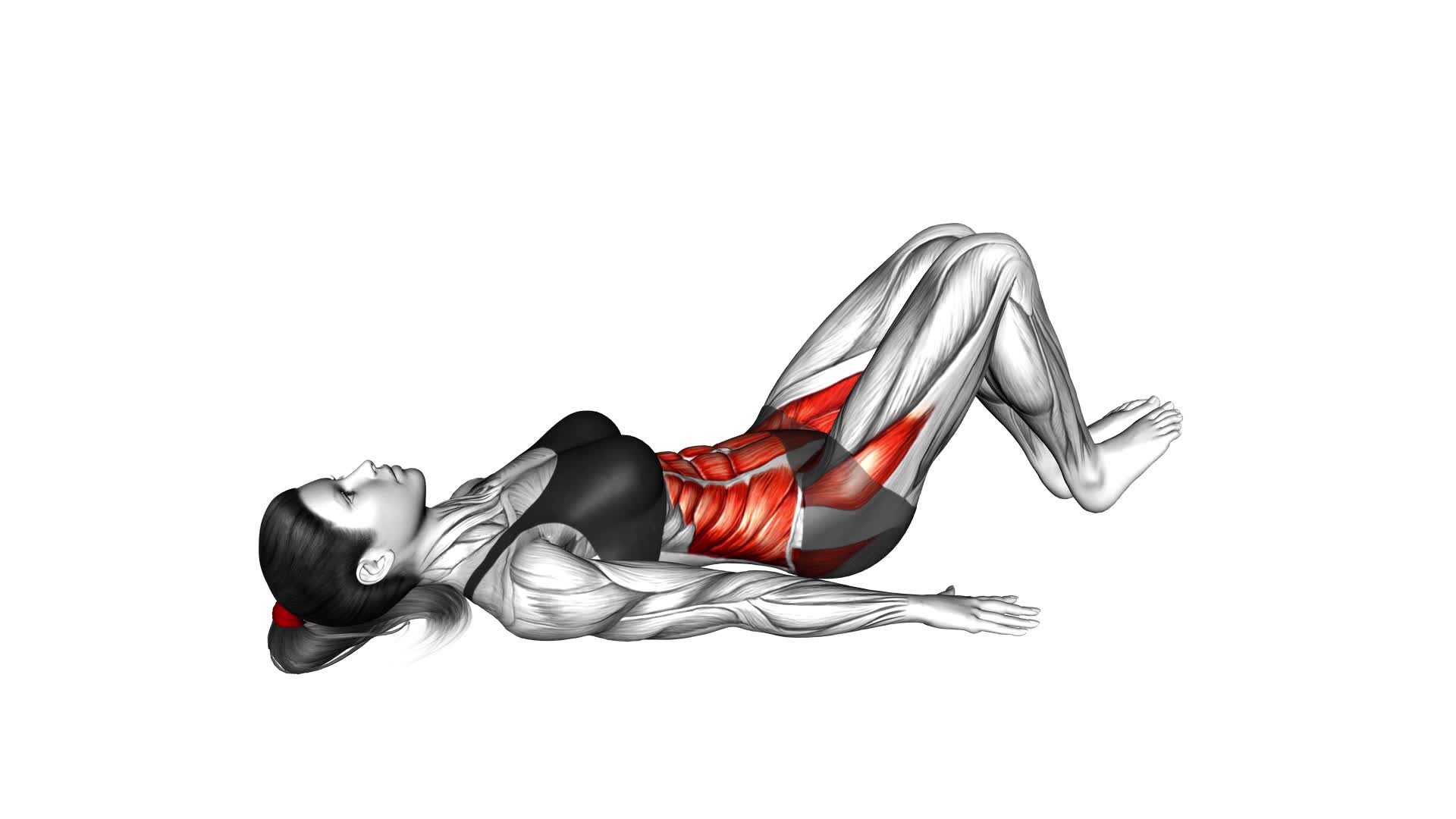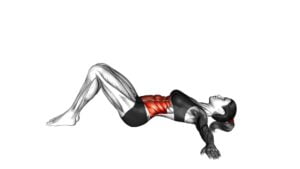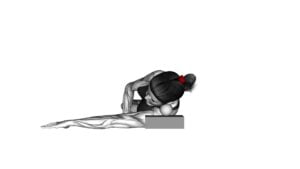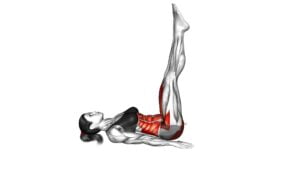Lying Bent Knee Side Roll (female) – Video Exercise Guide & Tips

Are you looking for a new exercise to target your core and improve your flexibility? Look no further than the lying bent knee side roll!
Watch This Exercise Video
In this quick and effective video exercise guide, we'll show you the proper form and technique, along with common mistakes to avoid.
Plus, we'll provide modifications and progressions to challenge yourself as you get stronger.
Get ready to feel the burn and achieve your fitness goals with the lying bent knee side roll.
Key Takeaways
- The lying bent knee side roll targets and strengthens the obliques.
- It improves stability, balance, flexibility, and range of motion in the hips and lower back.
- There are different variations of the exercise that can target different areas of the core.
- The exercise can be made more challenging by adding resistance or performing on an unstable surface.
Benefits of the Lying Bent Knee Side Roll
You will experience several benefits from incorporating the lying bent knee side roll into your fitness routine. This exercise primarily targets your obliques, or side abdominal muscles, helping to strengthen and tone them. By engaging your core muscles, you'll improve your overall stability and balance. Additionally, the lying bent knee side roll can help improve your flexibility and range of motion in your hips and lower back.
One of the key benefits of this exercise is its versatility. There are several variations you can try to target different areas of your core and challenge your muscles in different ways. For example, you can perform the exercise with your legs straight instead of bent, which increases the difficulty and engages your hip flexors and lower abs more intensely. You can also add resistance by holding a dumbbell or medicine ball to increase the intensity and further engage your muscles.
Another variation is to perform the exercise on an unstable surface, such as a stability ball, which adds an extra challenge to your core stability and balance. This variation also activates more muscles in your legs and upper body as you work to maintain your balance.
Incorporating the lying bent knee side roll into your fitness routine can provide you with numerous benefits, including improved core strength, stability, flexibility, and balance. By trying different variations, you can challenge your muscles in various ways and continue to progress in your fitness journey.
Proper Form and Technique for the Lying Bent Knee Side Roll
Achieving proper form and technique is essential for maximizing the effectiveness of the Lying Bent Knee Side Roll exercise. By maintaining the correct form, you can target the desired muscles and avoid potential injuries.
One of the benefits of proper form is that it helps engage the obliques and strengthen the core muscles effectively. When performing the Lying Bent Knee Side Roll, it's important to keep your core engaged throughout the movement. This will help stabilize your body and prevent excessive strain on the lower back.
To ensure proper technique, start by lying on your side with your knees bent and stacked on top of each other. Place your bottom arm straight out in front of you to create a stable base. As you roll your knees towards the floor, exhale and engage your obliques. Keep your shoulders and hips stacked and avoid lifting your hips off the ground.
There are common mistakes that you should avoid when performing this exercise. One mistake is allowing your top knee to fall forward or backward, which can reduce the effectiveness of the exercise. Another mistake is lifting your hips off the ground, which can strain your lower back.
Common Mistakes to Avoid During the Lying Bent Knee Side Roll
To ensure proper execution of the Lying Bent Knee Side Roll, it's crucial to avoid common mistakes that can hinder the effectiveness of the exercise. Here are some common mistakes to avoid and tips on how to correct them:
- Allowing the top leg to collapse: One common mistake is letting the top leg collapse onto the bottom leg during the roll. This reduces the activation of the glute muscles and limits the effectiveness of the exercise. To avoid this, focus on keeping the top leg lifted and engaged throughout the movement.
- Using momentum instead of control: Another mistake is relying on momentum to roll from side to side. This takes away from the targeted muscle activation and can lead to improper form. Instead, focus on using controlled movements and engaging your core muscles to initiate the roll.
- Not maintaining proper alignment: It's important to maintain proper alignment throughout the exercise. This means keeping your hips stacked, shoulders relaxed, and core engaged. Avoid letting your hips sag or your shoulders hunch forward, as this can lead to strain on the lower back.
Modifications and Progressions for the Lying Bent Knee Side Roll
Now let's explore some advanced progressions and safety modifications for the Lying Bent Knee Side Roll exercise.
If you're looking to challenge yourself further, we'll discuss ways to take this exercise to the next level.
On the other hand, if you're a beginner or have any safety concerns, we'll also cover modifications to ensure you can perform the exercise safely and effectively.
Advanced Progressions for Roll
Start by incorporating more challenging variations and modifications into your Lying Bent Knee Side Roll exercise. These advanced progressions will help you further strengthen your core stability and enhance the effectiveness of the exercise.
Here are three variations to try:
- Extended Leg Roll: Instead of keeping both knees bent, extend one leg straight out while performing the roll. This increases the demand on your core muscles and requires more stability.
- Russian Twist Roll: As you roll to each side, incorporate a Russian Twist by rotating your upper body towards the ceiling. This adds an extra rotational component to the exercise, targeting your obliques and increasing the challenge.
- Weighted Roll: Hold a dumbbell or medicine ball close to your chest while performing the roll. The added weight will engage your core muscles even more, making the exercise more challenging and effective.
Incorporating these advanced modifications into your Lying Bent Knee Side Roll will take your core stability exercises to the next level, helping you achieve greater strength and stability.
Safety Modifications for Beginners
As you progress from the advanced variations of the Lying Bent Knee Side Roll, it's important to incorporate safety modifications for beginners to ensure proper form and minimize the risk of injury.
For beginners, it's recommended to start with a smaller range of motion and gradually increase it as you become more comfortable with the exercise. This can be done by rolling only a few inches to each side instead of going all the way to the floor.
Additionally, beginners can keep their top hand on the floor for added stability and support. It's also important to listen to your body and take breaks as needed.
By implementing these beginner modifications, you can prevent injuries and safely build up your strength and flexibility.
Now, let's move on to some tips for getting the most out of the lying bent knee side roll.
Tips for Getting the Most Out of the Lying Bent Knee Side Roll
To get the most out of the Lying Bent Knee Side Roll, focus on maintaining correct form techniques throughout the exercise.
This includes keeping your core engaged, your spine aligned, and your shoulders relaxed.
Remember to breathe deeply and exhale as you roll your knees to the side, allowing for better muscle activation and relaxation.
Correct Form Techniques
Maximize the effectiveness of your Lying Bent Knee Side Roll by focusing on proper form techniques. To ensure correct posture and proper alignment, follow these tips:
- Lie on your side with your knees bent and stacked on top of each other, keeping your body in a straight line.
- Place your bottom arm straight out in front of you, palm facing down, to provide stability and support.
- Slowly roll your top knee towards the ground, keeping your feet together and maintaining contact between your knees.
By maintaining correct posture and alignment throughout the exercise, you'll engage the targeted muscles effectively and reduce the risk of injury.
Remember to listen to your body and modify the exercise as needed. With proper form, you can maximize the benefits of the Lying Bent Knee Side Roll and achieve optimal results.
Breathing During Exercise
To get the most out of the Lying Bent Knee Side Roll, focus on proper breathing technique. Breathing techniques play a crucial role in maximizing the benefits of this exercise. By inhaling deeply through your nose and exhaling fully through your mouth, you can enhance your body's oxygen intake and release toxins more effectively.
Deep breathing also helps to engage your core muscles, stabilize your spine, and improve overall body control during the movement. In addition, proper breathing helps to reduce muscle tension and promote relaxation, allowing you to perform the exercise more efficiently and with less effort.
Muscle Activation Cues
Focus on engaging your core muscles and activating your glutes to get the most out of the Lying Bent Knee Side Roll. Here are some muscle activation cues and breathing techniques to help you optimize your workout:
- Engage your core: Imagine pulling your belly button towards your spine to activate your deep abdominal muscles. This will help stabilize your torso and protect your lower back.
- Squeeze your glutes: Focus on squeezing your glute muscles as you lift and lower your legs. This won't only activate your glutes but also help to stabilize your hips and pelvis.
- Use proper breathing techniques: Inhale deeply through your nose before you start the movement, and exhale fully through your mouth as you lift and lower your legs. This will help you maintain control and stability throughout the exercise.
By following these muscle activation cues and breathing techniques, you can ensure that you're getting the most out of the Lying Bent Knee Side Roll.
Now, let's move on to the next section where we'll discuss safety precautions and considerations for this exercise.
Safety Precautions and Considerations for the Lying Bent Knee Side Roll
Ensure you have a stable and supportive surface before attempting the lying bent knee side roll. This exercise requires you to roll onto your side while keeping your knees bent. To perform it safely, there are a few key considerations to keep in mind.
Firstly, it's important to make any necessary safety modifications based on your individual abilities and limitations. If you have any pre-existing injuries or conditions that may be aggravated by this exercise, consult with a healthcare professional before attempting it. They can provide guidance on how to modify the exercise to suit your needs and ensure your safety.
Additionally, proper breathing techniques are essential during the lying bent knee side roll. As you roll onto your side, exhale and engage your core muscles to maintain stability and control. Inhale as you return to the starting position. This coordinated breathing pattern helps to support your body and maintain proper form throughout the exercise.
Frequently Asked Questions
How Many Calories Does the Lying Bent Knee Side Roll Burn?
The lying bent knee side roll is a great exercise for targeting your obliques and strengthening your core. When performed correctly, it can help you burn calories and tone your waistline.
To properly perform the lying bent knee side roll, start by lying on your side with your knees bent. Then, roll your hips and torso towards the floor, engaging your obliques.
There are variations and modifications you can try to challenge yourself or make the exercise easier.
Can the Lying Bent Knee Side Roll Help Improve Flexibility?
Incorporating the lying bent knee side roll into your workout routine can definitely help improve flexibility. By engaging your core and stretching your side muscles, this exercise targets the obliques and promotes greater range of motion.
To modify the exercise, you can start with smaller side rolls and gradually increase the intensity as you become more comfortable.
The benefits of incorporating the lying bent knee side roll into your routine include improved flexibility, increased core strength, and enhanced overall stability.
How Often Should I Perform the Lying Bent Knee Side Roll for Best Results?
To get the best results from the lying bent knee side roll, you should perform it regularly. The frequency of your workouts will depend on your fitness goals and current level of flexibility. However, it's generally recommended to incorporate this exercise into your routine at least 2-3 times a week.
Can the Lying Bent Knee Side Roll Help Reduce Lower Back Pain?
The lying bent knee side roll can be used as a core strengthening exercise. It targets the obliques, helping to improve overall core stability.
Additionally, the exercise can be modified for individuals with limited mobility by adjusting the range of motion and providing support if needed.
Are There Any Alternative Exercises That Target the Same Muscles as the Lying Bent Knee Side Roll?
If you're looking for alternative exercises to target the same muscles as the lying bent knee side roll, there are a couple of options you can try.
First, the side plank with leg lifts is a great exercise that engages your obliques and glutes.
Another option is the standing hip abduction with a resistance band, which also targets your glutes and outer thighs.
Both of these exercises can be effective in strengthening and toning your core and lower body muscles.
Conclusion
In conclusion, the lying bent knee side roll is a beneficial exercise that targets the core and oblique muscles. By maintaining proper form and technique, you can maximize the effectiveness of this exercise and avoid common mistakes.
Modifications and progressions can be made to suit your fitness level, while following safety precautions is essential to prevent injuries.
With these tips in mind, you can make the most out of the lying bent knee side roll and achieve your fitness goals.

Author
Years ago, the spark of my life’s passion ignited in my mind the moment I stepped into the local gym for the first time. The inaugural bead of perspiration, the initial endeavor, the very first surge of endorphins, and a sense of pride that washed over me post-workout marked the beginning of my deep-seated interest in strength sports, fitness, and sports nutrition. This very curiosity blossomed rapidly into a profound fascination, propelling me to earn a Master’s degree in Physical Education from the Academy of Physical Education in Krakow, followed by a Sports Manager diploma from the Jagiellonian University. My journey of growth led me to gain more specialized qualifications, such as being a certified personal trainer with a focus on sports dietetics, a lifeguard, and an instructor for wellness and corrective gymnastics. Theoretical knowledge paired seamlessly with practical experience, reinforcing my belief that the transformation of individuals under my guidance was also a reflection of my personal growth. This belief holds true even today. Each day, I strive to push the boundaries and explore new realms. These realms gently elevate me to greater heights. The unique combination of passion for my field and the continuous quest for growth fuels my drive to break new ground.







